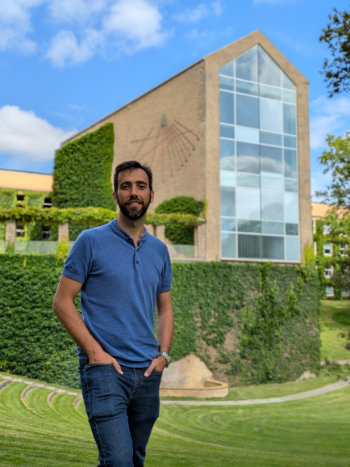Dr. Xavier Bofill de RosWritten by: Julieta Rivosecchi, PhD Posted: February 19, 2025  Dr. Xavier Bofill de Ros recently opened his lab in the Department of Molecular Biology and Genetics at Aarhus University, Denmark. The foundation of his current research endeavours was laid early on in his career when he was a PhD student studying gene therapy. It was then Xavier first got in contact with the potential of microRNAs (miRNAs) to prevent viral replication. This initial exposure sparked his curiosity about the regulation of miRNAs and their molecular mechanisms of action so much that he decided to contribute to advancing our understanding of how deregulation of miRNA biogenesis and decay pathways can alter gene expression in cancer. As an miRNA scientist, he recognizes that “one of the biggest challenges in the field is understanding how individual interactions between microRNAs and target mRNAs impact (or not) cellular or physiological responses.” He is acutely aware of the therapeutic potential that small RNAs have. Together with his lab, he is working on developing therapeutics based on small RNAs and RNA metabolism, a field he is particularly optimistic about: “There is still a lot of ground to cover for that end goal, but it is very exciting to see that more and more co-factors that modulate microRNA biogenesis are being uncovered. Some of those would make very interesting candidates to target pharmacologically.” Having completed his undergraduate and graduate studies at the University of Barcelona, Spain, and postdoctoral research at the National Cancer Institute - National Institutes of Health in the USA, Dr. Bofill de Ros returned to Europe to establish his laboratory at Aarhus University. His career exemplifies the international path that many scientists navigate in the pursuit of knowledge and mentoring to gain a more diverse perspective to advance their careers. He feels that his experiences across the U.S. and Europe have definitely enriched his perspective, allowing him to appreciate the strengths of both regions: “From the U.S., I like the vast amount of opportunities to do projects that go from cutting-edge basic science to translational research. From Europe, I like the ease of collaboration or to share knowledge and equipment.” Despite having to move across continents, which some may find a big career and personal challenge, Xavier believes that his biggest challenge is taking place right now: “I find it quite difficult to carve your own research niche different from your previous mentors. I try to be at the intersection between what I learned during my PhD and my postdoc while trying to apply to new exciting questions.” Fortunately, during the transition from being a postdoc to a group leader, Dr. Bofill de Ros received strong support from his postdoctoral supervisor, Dr. Shuo Gu, who set the tone on how to be a good leader: “He was very open on how he made decisions in the lab, and that gave me a very unique perspective on how to get a new lab up and running,” he recalls. Xavier is grateful to many other colleagues who helped him with feedback on proposals and writing collaboration letters, and especially to Dr. Sandy Wolin and Dr. Lino Tessarollo. Another challenging aspect for Dr. Bofill de Ros was the lifestyle and family relocation, which he sees as important considerations when transitioning in the career when reflecting on how personal and professional lives intertwine in academia.
He feels inspired by the work of prominent figures in RNA research, such as Dr. David Bartel, Dr. Narry Kim, Dr. Josh Mendell, and Dr. Jonathan Weissman. “Their work is always moving the RNA field forward and has a unique combination of top notch experimental approaches and computational analysis”, he explains. Throughout his career, Xavier has experienced numerous “eureka” moments, “when the data basically talks by itself.” In particular, during his postdoctoral studies, he was very excited when he found “cancer patients that presented mutations in the Argonaute PAZ domain that exhibited the same trimming and tailing of microRNAs that we were seeing in biochemical studies”. He also attributes much of his excitement to witnessing how projects unfold with the contribution of internal and external collaborators. Thus, Dr. Bofill de Ros encourages graduate students to engage in open discussions with their mentors and emphasizes the importance of dedication and long-term vision: “Be passionate and focus on the long term goals of your career, while you keep up with doing good work on a daily basis”. As a member of the RNA Society, Dr. Bofill de Ros participated in promoting the RNA Journal through the journal’s Twitter/X account and attended the annual RNA Society meetings. His holistic approach to balancing both personal and professional lives is exemplified by a memorable moment at the 2018 RNA Society meeting. “I travelled to the meeting not only with a poster but also with an engagement ring. We got engaged in the days before the meeting started”, Dr. Bofill de Ros shares with joy. His favourite article in the RNA Journal is Mansur et al. (2016), in which the authors characterized the 3’ adenylation of miRNAs in a mouse model and phenotypes on behaviour. To discuss with Dr. Bofill de Ros about microRNAs, and more, find him on Twitter/X at @xbdr86, BlueSky at xbdr86.bsky.social and on his LinkedIn page https://www.linkedin.com/in/xavier-bofill-de-ros-phd-70838b28/. |
